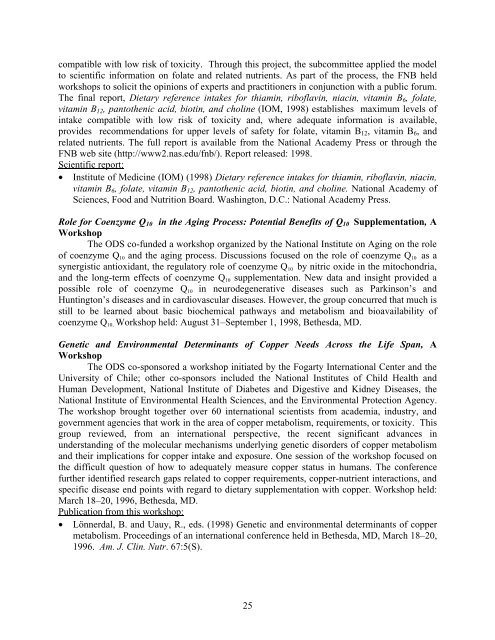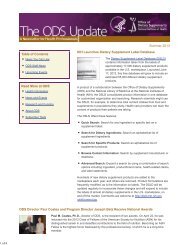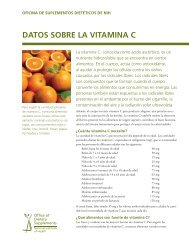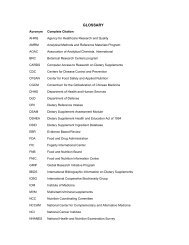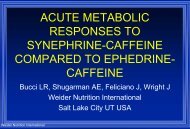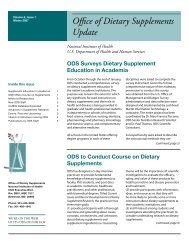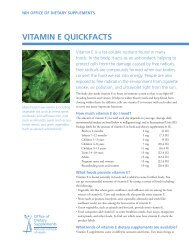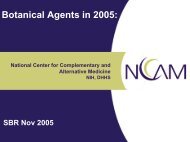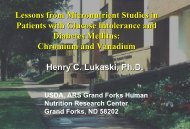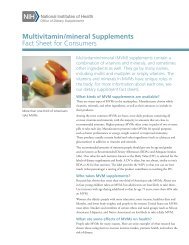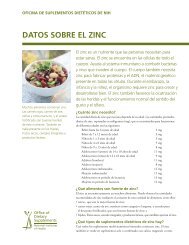status report - Office of Dietary Supplements - National Institutes of ...
status report - Office of Dietary Supplements - National Institutes of ...
status report - Office of Dietary Supplements - National Institutes of ...
Create successful ePaper yourself
Turn your PDF publications into a flip-book with our unique Google optimized e-Paper software.
compatible with low risk <strong>of</strong> toxicity. Through this project, the subcommittee applied the model<br />
to scientific information on folate and related nutrients. As part <strong>of</strong> the process, the FNB held<br />
workshops to solicit the opinions <strong>of</strong> experts and practitioners in conjunction with a public forum.<br />
The final <strong>report</strong>, <strong>Dietary</strong> reference intakes for thiamin, rib<strong>of</strong>lavin, niacin, vitamin B 6 , folate,<br />
vitamin B 12 , pantothenic acid, biotin, and choline (IOM, 1998) establishes maximum levels <strong>of</strong><br />
intake compatible with low risk <strong>of</strong> toxicity and, where adequate information is available,<br />
provides recommendations for upper levels <strong>of</strong> safety for folate, vitamin B 12 , vitamin B 6 , and<br />
related nutrients. The full <strong>report</strong> is available from the <strong>National</strong> Academy Press or through the<br />
FNB web site (http://www2.nas.edu/fnb/). Report released: 1998.<br />
Scientific <strong>report</strong>:<br />
• Institute <strong>of</strong> Medicine (IOM) (1998) <strong>Dietary</strong> reference intakes for thiamin, rib<strong>of</strong>lavin, niacin,<br />
vitamin B 6 , folate, vitamin B 12 , pantothenic acid, biotin, and choline. <strong>National</strong> Academy <strong>of</strong><br />
Sciences, Food and Nutrition Board. Washington, D.C.: <strong>National</strong> Academy Press.<br />
Role for Coenzyme Q 10 in the Aging Process: Potential Benefits <strong>of</strong> Q 10 Supplementation, A<br />
Workshop<br />
The ODS co-funded a workshop organized by the <strong>National</strong> Institute on Aging on the role<br />
<strong>of</strong> coenzyme Q 10 and the aging process. Discussions focused on the role <strong>of</strong> coenzyme Q 10 as a<br />
synergistic antioxidant, the regulatory role <strong>of</strong> coenzyme Q 10 by nitric oxide in the mitochondria,<br />
and the long-term effects <strong>of</strong> coenzyme Q 10 supplementation. New data and insight provided a<br />
possible role <strong>of</strong> coenzyme Q 10 in neurodegenerative diseases such as Parkinson’s and<br />
Huntington’s diseases and in cardiovascular diseases. However, the group concurred that much is<br />
still to be learned about basic biochemical pathways and metabolism and bioavailability <strong>of</strong><br />
coenzyme Q 10. Workshop held: August 31–September 1, 1998, Bethesda, MD.<br />
Genetic and Environmental Determinants <strong>of</strong> Copper Needs Across the Life Span, A<br />
Workshop<br />
The ODS co-sponsored a workshop initiated by the Fogarty International Center and the<br />
University <strong>of</strong> Chile; other co-sponsors included the <strong>National</strong> <strong>Institutes</strong> <strong>of</strong> Child Health and<br />
Human Development, <strong>National</strong> Institute <strong>of</strong> Diabetes and Digestive and Kidney Diseases, the<br />
<strong>National</strong> Institute <strong>of</strong> Environmental Health Sciences, and the Environmental Protection Agency.<br />
The workshop brought together over 60 international scientists from academia, industry, and<br />
government agencies that work in the area <strong>of</strong> copper metabolism, requirements, or toxicity. This<br />
group reviewed, from an international perspective, the recent significant advances in<br />
understanding <strong>of</strong> the molecular mechanisms underlying genetic disorders <strong>of</strong> copper metabolism<br />
and their implications for copper intake and exposure. One session <strong>of</strong> the workshop focused on<br />
the difficult question <strong>of</strong> how to adequately measure copper <strong>status</strong> in humans. The conference<br />
further identified research gaps related to copper requirements, copper-nutrient interactions, and<br />
specific disease end points with regard to dietary supplementation with copper. Workshop held:<br />
March 18–20, 1996, Bethesda, MD.<br />
Publication from this workshop:<br />
• Lönnerdal, B. and Uauy, R., eds. (1998) Genetic and environmental determinants <strong>of</strong> copper<br />
metabolism. Proceedings <strong>of</strong> an international conference held in Bethesda, MD, March 18–20,<br />
1996. Am. J. Clin. Nutr. 67:5(S).<br />
25


